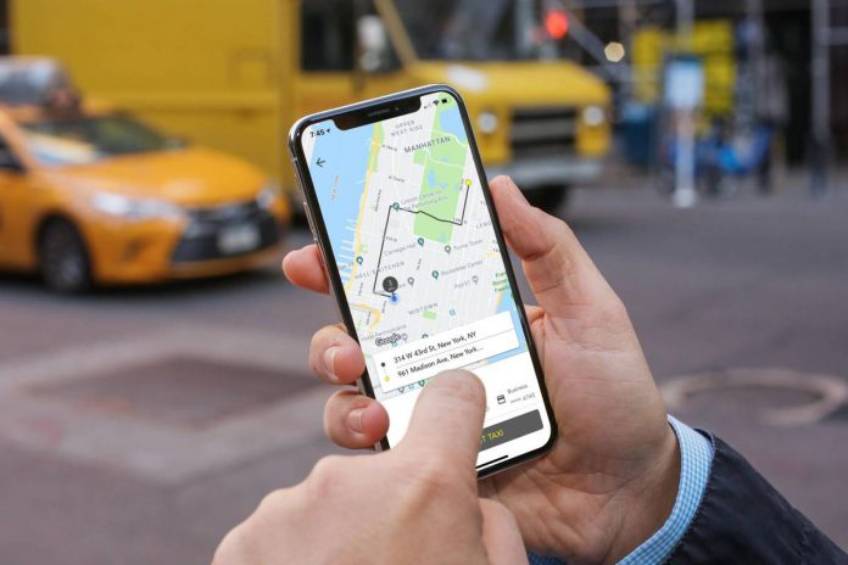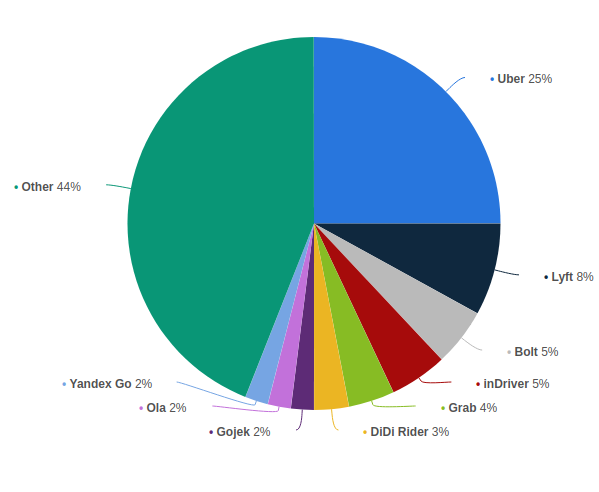
How to Make an Uber Like App?
In bustling metropolitan areas, where the hustle of traffic and the scarcity of parking spaces are everyday realities, many residents are opting out of car ownership in favor of ridesharing services like Uber. This growing preference for on-demand car services is prompting entrepreneurs and transportation companies alike to explore the development of Uber-like applications, eyeing a share in the lucrative ridesharing market.
The surge in rideshare app development is largely fueled by Uber's remarkable success, inspiring new entrants to venture into the market with hopes of capturing their own segment. The landscape is increasingly competitive, with numerous apps emerging to challenge the status quo, each driven by the ambition to emulate Uber's global claims.
For those contemplating the launch of a rideshare application, understanding Uber's technological innovations and business strategies is crucial. This insight not only serves as a blueprint for success but also highlights the complexities and costs associated with developing a rideshare app that can compete on both local and international stages. Let's delve into the essentials of creating an Uber-like app, unraveling the steps and investments involved.
Creating an app like Uber involves careful planning and strategic decision-making. This blog provides a step-by-step guide on how to make an app like Uber, covering crucial aspects such as market research, feature selection, and the technology stack. Explore the design considerations and user experience elements that contribute to the success of ride-hailing apps. Whether you're a startup or an established business looking to diversify, this guide offers valuable insights into the process of creating a competitive and innovative app like Uber.
How Does the Uber App Work?

The basic design architecture of the taxi service app should be user-friendly and straightforward. The same should also hold for the profile creation page. Before using this app, the user has to create a registered account with this platform. It should include the name, password and contact details of the user.
- Trip Request: When you want a ride, you open the app and enter your destination. The app shows the fare estimate, different types of available rides (like UberX, UberPool, etc.), and how long it will take for a driver to get to your location.
- Trip Confirmation: A clear, immediate notification that the booking has been successfully made, including the date and time of confirmation.
- Matching Process: Once you choose your ride type and confirm your pickup location, the app sends your request to nearby drivers. When a driver accepts your request, the app displays the driver’s details, including name, photo, vehicle type, and license plate number. You can also track their arrival on the map.
- Ride: The driver arrives and takes you to your destination. The route can be followed on the app's map, and some versions of the app allow for route changes or specific drop-off instructions.
- Payment Procedure: Payment is cashless, processed automatically through the app using the payment method you've linked to your account (like a credit card or PayPal). After the ride, you’re given the opportunity to rate the driver, which helps ensure quality and safety.
- Rating and Review: The rating feature in the Uber app is designed to be straightforward and user-friendly, facilitating a vital communication channel between riders and drivers.
Uber also offers other services through its platform, such as food delivery with Uber Eats and freight carrying services with Uber Freight, expanding its business model beyond just passenger transportation.
Uber Statistics

The ridesharing industry has experienced remarkable growth recently, with Uber emerging as a standout example of success within this sector. Transitioning from a simple taxi-hailing service to a multi-billion-dollar enterprise, Uber's financial achievements underscore the sector's potential. Specifically, in 2019, Uber reported a global net revenue of $14.1 billion, highlighting the substantial economic impact and market acceptance of ridesharing platforms. This financial milestone not only reflects Uber's dominant position in the market but also illustrates the increasing reliance on and popularity of ridesharing services among consumers worldwide.
Uber has solidified its position as the premier global ridesharing application, boasting availability in 10,000 cities across 71 countries. Since its inception in 2009, Uber rapidly achieved significant milestones, reaching $1 billion in annualized gross bookings within just 16 months. Presently, the platform is utilized by 93 million customers, supported by a robust network of 3.5 million drivers. In the year 2020, Uber's ride sharing segment processed gross bookings totaling $26.61 billion, highlighting its substantial impact and dominance in the mobility services market.
How to Develop an app like Uber
Developing an app like Uber involves several steps, each critical to ensure the app's success in the competitive ride-sharing market. Here's a step-by-step guide to help you understand the process:
1. Market Research and Idea Validation
- Identify Your Niche: Research the market to identify gaps in current offerings. Decide if you want to target a specific geographic area, demographic, or type of service (e.g., luxury cars, pet-friendly rides).
- Understand Your Competitors: Analyze competitors to understand their strengths and weaknesses.
- Validate Your Idea: Use surveys, focus groups, or a minimal viable product (MVP) to validate your idea with potential users.
2. Define Your Business Model
- Revenue Model: Decide how you will generate revenue—through fares, subscription models, advertising, or a combination of these.
- User Acquisition Strategy: Plan how you will attract both riders and drivers to your platform.
- Partnerships: Consider partnerships with local businesses or events to promote your service.
3. Legal Considerations
- Regulatory Compliance: Understand and comply with local laws and regulations related to ride-sharing services.
- Insurance: Ensure you have the necessary insurance to protect your company, drivers, and passengers.
- Company Structure: Decide on your company's legal structure (e.g., LLC, corporation) for tax and liability purposes.
4. App Development
- Requirement Analysis: List all the features your app will need, for both driver and rider apps, including GPS navigation, fare estimation, payment integration, and ratings.
- UI/UX Design: Design a user-friendly interface for both drivers and riders. Prioritize simplicity and ease of use.
- Technology Stack: Choose the right technologies for frontend and backend development, considering scalability, performance, and maintenance.
- Development Approach: Decide whether to develop in-house, hire freelancers, or partner with a development agency.
- MVP Development: Start with developing a minimal viable product (MVP) to launch quickly and gather user feedback.
5. Testing
- Quality Assurance: Conduct thorough testing for bugs, usability, and security vulnerabilities. This should include both automated and manual testing.
- Beta Testing: Release the app to a limited audience to collect feedback and identify areas for improvement.
6. Launch
- Soft Launch: Consider launching in a limited area or market first to manage the rollout and address any issues.
- Marketing and PR: Develop a marketing plan to promote your app through social media, influencers, press releases, and partnerships.
7. Post-Launch Support and Updates
- Customer Support: Provide robust support for both riders and drivers to handle issues and complaints.
- Iterative Development: Use feedback from users to prioritize and develop new features. Continuously improve the app based on user needs and market trends.
- Scalability: Plan for scalability from the start, ensuring your backend infrastructure can handle increased load as your user base grows.
8. Monetization and Growth Strategies
- Monetization Strategies: Explore additional revenue streams such as in-app advertising, premium features, or corporate partnerships.
- Expansion: Consider geographic expansion or expanding to related services (e.g., food delivery, parcel delivery) once your app has established a strong user base in its initial market.
Essential Uber-like App Features
Developing an app like Uber is a complex and time-consuming process, requiring careful planning, execution, and ongoing management. Success in the ride-sharing industry requires not just a functional and user-friendly app, but also a strong business model, effective marketing, and a commitment to continuous improvement and customer satisfaction. Here are features of Uber Clone App as per given below:
Passenger app
The Passenger App is a pivotal component of ride-sharing services, designed to provide users with a seamless and intuitive interface for booking rides, tracking drivers, managing payments, and reviewing their journey experiences. It's the direct point of interaction between the service and the passengers, making its usability, reliability, and efficiency crucial for ensuring customer satisfaction and loyalty. Here are some important features as per given below:
1. Chat Feature using Sockets: The application incorporates a socket-based chat mechanism, enabling seamless and swift communication between riders and drivers directly within the app.
2. Vehicle Categories: The platform is designed with exceptional flexibility, allowing real-time control of categories directly from the admin panel. This enables administrators to add, edit, or remove categories, adjust pricing, and modify additional settings without downtime.
3. OTP On Trip Start: To enhance rider security and prevent fare manipulation, we implemented a feature requiring riders to provide a One-Time Password (OTP) before the driver can commence the ride. This measure was introduced in response to instances where drivers initiated rides prior to picking up the rider, leading to unfair fare increases. By mandating an OTP from the rider, we aim to deter fraudulent activities, ensuring a safer and more trustworthy experience for all users.
4. Outstation: The platform now includes an outstation booking feature, enabling riders to reserve rides for long distances. Furthermore, this option allows for the booking of outstation trips for a variable number of days, tailored to the specific needs of the rider.
5. Live Tracking: The taxi app incorporates real-time tracking of the driver's location during the ride. An added feature allows the admin to monitor all drivers on a map, enhancing operational oversight. Additionally, riders have the option to share their ride details with family and friends, who can then track the rider's location on the map for increased safety and peace of mind.
6. Rentals: The taxi app also offers a rentals feature, alongside the immediate ride option. Rentals function as predefined packages, where prices are set for specific distances and durations. For instance, a package offering 4 hours and 40 kilometers is priced at $120. This addition provides riders with greater flexibility, allowing them to select packages that best fit their requirements.
Driver app
The Driver App is a critical component of ride-sharing platforms, designed to facilitate drivers with the tools they need for efficient operation, communication, and navigation. This app serves as the backbone for drivers, enabling them to accept ride requests, navigate to the passenger's location, manage their earnings, and communicate with passengers. Here's a breakdown of key features typically found in a driver app:
Multi-language: The admin panel enables complete management of app localizations. This means, for instance, that clients have the ability to incorporate multiple languages into the taxi app and oversee the translations within the admin panel.
Driver Statistics: Prior to determining the optimal method for displaying statistics, we conducted an extensive analysis on client data. This research has enabled us to provide drivers and administrators with comprehensive insights for improved planning. Drivers now have access to detailed performance metrics, including daily and monthly overviews, as well as in-depth statistics covering completed rides, rejections, and missed opportunities.
In-app Turn-by-turn Navigation: Our app distinguishes itself from competitors with its in-app turn-by-turn navigation feature, achieving unparalleled accuracy in map navigation and providing seamless, in-app turn-by-turn directions. This eliminates the need for drivers to switch between our app and external navigation apps like Google Maps or Waze. We are currently developing voice instruction capabilities to enhance this feature further.
Smart Referrals & Rewards: The development of this feature was informed by surveys conducted with over 100 live clients, ensuring it meets real-world needs effectively. Additionally, we have focused on making the system robust in terms of implementation.
Smart Fare Management System: In response to the diverse needs of our clientele, we've designed a fare management system that's both flexible and dynamic, allowing for comprehensive adjustments and control directly from the taxi app's admin panel. Additionally, we've prioritized transparency in fare calculation by displaying it in real-time on the driver's application screen throughout the ride. This ensures a clear and trustworthy process for both drivers and passengers, enhancing the overall experience.
Driver Documents: As per every country's varying requirements and laws, we have made it configurable to add or change the documents required for the drivers to sign up on the platform. So clients need to be reassured about the changing laws in the future.
Admin Panel
The Admin Panel serves as the control center for ride-sharing platforms, providing administrators with comprehensive tools to manage both the rider and driver experiences, monitor operations, and make data-driven decisions. This web-based dashboard is crucial for maintaining the smooth functioning of the service, overseeing user activity, resolving disputes, and enhancing overall service quality. Key features of an Admin Panel include:
Drivers Manager: The admin panel is empowered to comprehensively manage driver access on the platform. This includes the ability to verify or block drivers, request additional documents, monitor their performance, review their wallet status, examine documents, oversee referrals, and much more. We've designed the admin role to act as a superpower, granting them full control over operational aspects in real-time.
Users Manager: Similarly, the driver manager is granted full authority over the rider's access to the platform. This role encompasses the ability to manage or observe their booked, canceled, and completed rides, as well as to resolve any issues or grievances directly from the panel.
Transactions Manager: The admin has the capability to monitor all transactions occurring on the platform. Additionally, they can delve into the specifics of each transaction, including taxes, commission, payment methods, wallet transfers, and more, ensuring a comprehensive understanding of the platform's financial flows.
Wallet Manager: The foundational advantage of our platform lies in its integrated wallet system, setting us apart from competitors. Once comprehended, it becomes evident that such a system is essential for business operations. This feature not only aids in retaining both riders and drivers by enhancing their engagement with the platform, but it also enables the company to maintain a higher level of funds, fostering a more robust economic ecosystem within the platform.
Trips/Rides Manager: The admin has the capability to monitor rides in real-time, including those that are ongoing, completed, canceled, missed, or rejected by drivers. Furthermore, the admin possesses the authority to dispatch rides directly from the admin panel and manually assign drivers to booked rides, offering a high level of operational control and flexibility in managing ride allocations.
Reports: The admin is provided with access to a wide range of reports, enabling them to effectively plan and strategize various activities aimed at supporting and expanding the business. These reports offer valuable insights into operations, financial performance, user engagement, and more, serving as a critical tool for informed decision-making and strategic development.
How Long Does It Take To Build An Uber Like App?
Building an app like Uber involves several stages, each with its own set of complexities and time requirements. The duration to develop a rideshare app similar to Uber can vary significantly based on several factors, including the scope of the app, the features you plan to include, the complexity of its design, the technology stack used, and the efficiency of your development team.
We have our ready-made Uber clone apps that offer a quick and cost-effective solution for entrepreneurs and businesses looking to enter the ride-sharing market. Our Uber clone apps are pre-built applications that mimic the core functionalities of successful ride-sharing apps like Uber. The whole process of developing a taxi app like Uber would take in between two to three weeks.
Conclusion
Developing an app like Uber is not just about replicating a successful model; it’s about innovating and adapting it to meet the unique needs of your target audience. As a leading taxi app development company, we understand the intricacies involved—from the initial market research to the deployment and scaling of your app. We are dedicated to providing our clients with robust, intuitive, and scalable mobile app solutions that not only meet but exceed customer expectations.
Remember, the key to a successful ride-sharing app lies in its ability to offer reliability, safety, and convenience. By incorporating a thoughtful design, a strong technical foundation, and ongoing support and enhancements, your app can stand out in a crowded marketplace. Whether you’re starting from scratch or looking to improve an existing service, we are here to guide you every step of the way.
Embrace the opportunity to transform the urban mobility landscape. With the right approach, your app can become the next big thing in the world of transportation. Let’s get moving partner with us to bring your vision to life and drive forward into a successful future.





